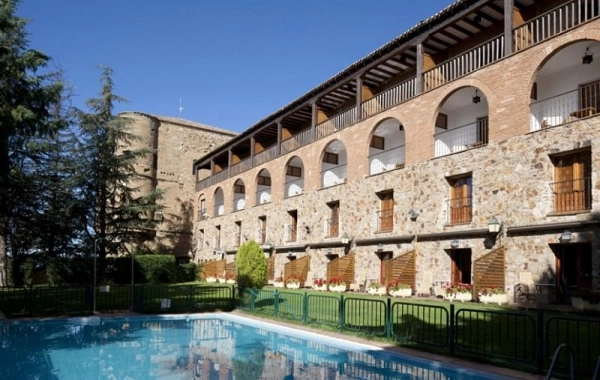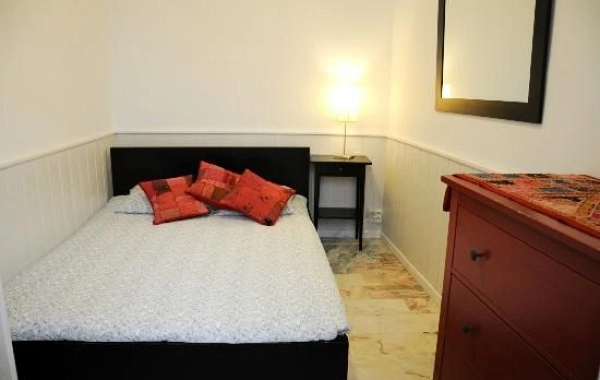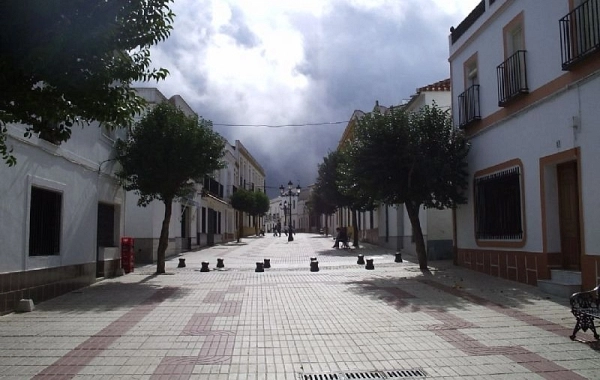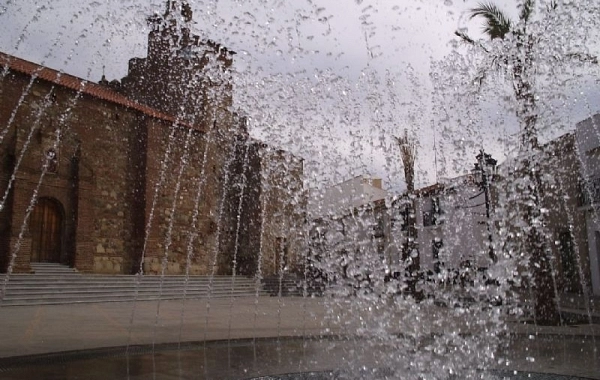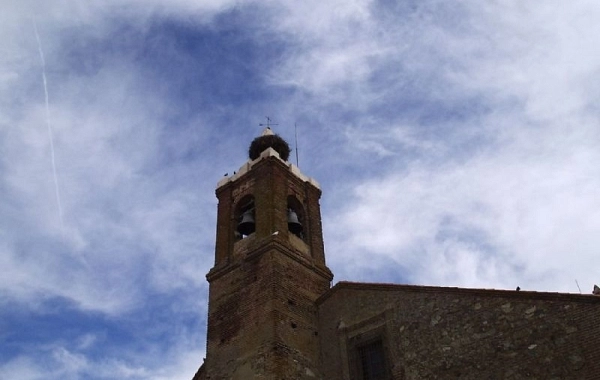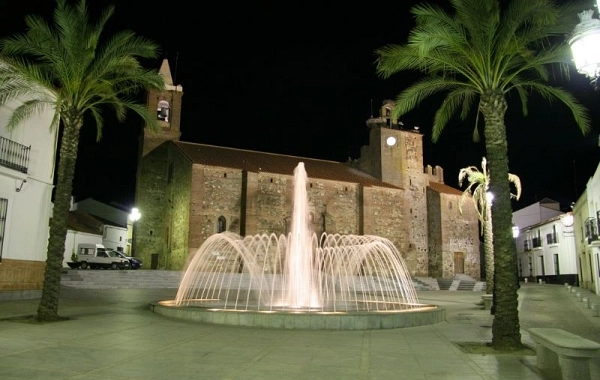VP04 - Almadén de la Plata-Monesterio - 34,5 km
Distance35 Km.Related packages
The route between Almadén de la Plata and Monesterio is a peaceful stage, yet filled with history and natural beauty. Along this approximately 30-kilometer route, pilgrims enjoy a mix of rural roads, natural landscapes, and historical monuments. The paths wind between holm oaks and cork oaks, with pilgrims passing by ancient castles and beautiful white villages.
Route Overview
Departure from Almadén de la Plata
The stage begins by leaving Almadén de la Plata via the road next to the bullring. The first stretch passes through holm oaks, a typical landscape of the Sierra Norte de Sevilla. Upon reaching the Casa de la Postura, the pilgrim turns right and passes by a pig trough, taking a path between rockroses and holm oaks that rises and falls until almost reaching the Almadén - El Real road. In this section, vegetation may obscure the arrows indicating the path, so it is recommended to stay alert to the signs.
The Arroyo de la Víbora Streambed
Continuing along the path, pilgrims follow the course of the Arroyo de la Víbora stream and soon reach the Arroyo Mateos estate. Here, a gate is crossed, and the journey continues past the keeper’s house. The route presents a steep descent to a stream, followed by an intense ascent. The route through the estate extends for about 5 km.
Path to El Real de la Jara
After leaving the estate, the pilgrim follows a nearly flat path until reaching El Real de la Jara. This village, which owes its name to the Camino Real, has historically been an important communication point between Andalusia and Extremadura. The area is surrounded by nature and has an interesting history dating back to the Muslim era.
El Real de la Jara
History of El Real de la Jara
The name El Real de la Jara comes from the Camino Real, an important communication route in the peninsula. During the Muslim era, especially in the year 1148, with the arrival of the Almohads, the population became more prominent. Located between hills to the north and south, El Real de la Jara has an elongated design that takes advantage of the landscape’s undulations.
What to See in El Real de la Jara
- Castle of El Real de la Jara: A historic castle offering panoramic views of the area.
- Castle of las Torres: Another significant monument, with a history linked to the region.
- Hermitage of Nuestra Señora de Los Remedios: A local place of worship worth visiting.
- Parish Church of San Bartolomé: A religious site of architectural and historical interest.
Continuing the Camino
From El Real de la Jara, pilgrims continue along the Camino de la Plata, a route that still retains its traditional name. After a brief climb, the path descends toward a stream, which is crossed, and to the right, an ancient castle can be seen, which, according to legend, was used to defend the passage of the Camino de Santiago.
On the Way to Monesterio
After crossing the Llerena road, pilgrims continue along the path and, after covering about 2 km next to the N-630, they leave the road for a few meters until reaching the Puerto de la Cruz. From here, they descend toward the village of Monesterio, a place full of history and an important reference on the Camino de Santiago.
Monesterio
History of Monesterio
Monesterio is known for its proximity to the Monastery of Nuestra Señora de Tentudía, an important monastery founded in the 15th century to commemorate the Christian victory over the Muslims. The town has a rich history dating back to Roman times, and its strategic location has made it a key point for communication between Andalusia and Extremadura.
What to See in Monesterio
- Parish Church of San Pedro: A religious building that stands out for its architecture.
- Hermitage of the Virgen de Tentudía: Another important place of worship, linked to the local religious tradition.
Tips for the Stage
- Provisioning: Although the route is mostly calm, make sure to bring enough water and food, as resupply points are limited.
- Appropriate Clothing and Footwear: Throughout the route, the terrain can be uneven, so it is recommended to wear comfortable clothing and suitable footwear for long walks with some elevation.
- Attention to Signs: In some sections, vegetation may hinder the visibility of the arrows, so it is important to stay alert to the map or the Camino de Santiago directions.
Summary
The stage between Almadén de la Plata and Monesterio is one of the most interesting on the Camino de Santiago, not only for its landscapes and the tranquility of its routes but also for the rich history of the villages along the way. From the historic El Real de la Jara to the emblematic Monesterio, pilgrims enjoy a route full of natural and cultural beauty, perfect for those seeking a more authentic and peaceful experience on their way to Santiago de Compostela.
Stages
- VP01 Sevilla - Guillena , 22 km
- VP02 - Guillena - Castilblanco de los Arroyos - 19 km
- VP03 - Castilblanco de los Arroyos - Almadén de la Plata - 29,5 km
- VP04 - Almadén de la Plata-Monesterio - 34,5 km
- VP05 - Monesterio-Fuente de Cantos - 21,6 km
- VP06 - Fuente de Cantos - Zafra - 24,6 km
- VP07 - Zafra - Almendralejo - 36,7 km
- VP08 - Almendralejo - Mérida - 29,6 km
- VP09 - Mérida - Alcuéscar - 36 km
- VP10 - Alcuéscar - Valdesalor - 25,7 km
- VP11 - Valdesalor - Casar de Cáceres - 22,8 km
- VP12 - Casar de Cáceres - Cañaveral - 33,2 km
- VP13 - Cañaveral - Galisteo - 28 km
- VP14 - Galisteo - Cáparra - 29,5 km
- VP15 - Cáparra - Baños de Montemayor - 28,5 km
- VP16 - Baños de Montemayor - Fuenterroble de Salvatierra - 32,9 km
- VP17 - Fuenterroble de Salvatierra - San Pedro de Rozados - 28 km
- VP18 - San Pedro de Rozados - Salamanca - 23,4 km
- VP19 - Salamanca- El Cubo de la Tierra del Vino - 35 km
- VP20 - El Cubo de la Tierra del Vino - Zamora - 31,6 km
- VP21 - Zamora - Montamarta - 18,5 km
- VP22 - Montamarta - Granja de Moreruela - 22,7 km
- VP23 - Granja de Moreruela - Benavente - 25,5 km
- VP24 - Benavente - Alija del Infantado - 22,1 km
- VP25 - Alija del Infantado - La Bañeza - 20,5 km
- VP26 - La Bañeza - Astorga - 24,2 km




